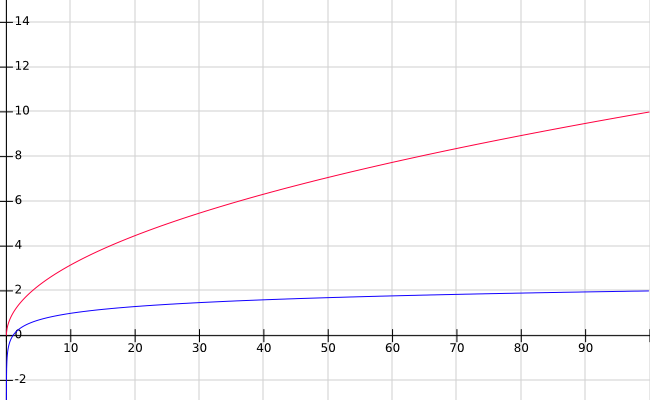SICP Exercise 1.24
Question
Modify the timed-prime-test procedure of exercise 1.22 to use fast-prime? (the Fermat method), and test each of the 12 primes you found in that exercise.
Since the Fermat test has
Answer
(define (square x) (* x x))
(define (expmod base exp m)
(cond ((= exp 0) 1)
((even? exp)
(remainder
(square (expmod base (/ exp 2) m))
m))
(else
(remainder
(* base (expmod base (- exp 1) m))
m))))
(define (fermat-test n)
(define (try-it a)
(= (expmod a n n) a))
(try-it (+ 1 (random (- n 1)))))
(define (fast-prime? n times)
(cond ((= times 0) true)
((fermat-test n)
(fast-prime? n (- times 1)))
(else false)))
(define (timed-prime-test n)
(start-prime-test n (runtime)))
(define (start-prime-test n start-time)
(if (fast-prime? n 5)
(report-prime n (- (runtime)
start-time))))
(define (report-prime number elapsed-time)
(display number)
(display " *** ")
(display elapsed-time)
(newline))
; ----solution----
(define (search-for-primes lower upper)
(cond ((even? lower) (search-for-primes (+ lower 1) upper))
((> lower upper) (newline))
(else (timed-prime-test lower)
(search-for-primes (+ lower 2) upper))))
; ----run----
(search-for-primes 1000000 1000038)
(search-for-primes 1000000 1000038)
(search-for-primes 1000000 1000038)
(search-for-primes 10000000 10000105)
(search-for-primes 10000000 10000105)
(search-for-primes 10000000 10000105)
(search-for-primes 100000000 100000040)
(search-for-primes 100000000 100000040)
(search-for-primes 100000000 100000040)
(search-for-primes 1000000000 1000000030)
(search-for-primes 1000000000 1000000030)
(search-for-primes 1000000000 1000000030)
Results:
1000003 *** 5
1000033 *** 5
1000037 *** 4
1000003 *** 4
1000033 *** 5
1000037 *** 5
1000003 *** 5
1000033 *** 5
1000037 *** 5
10000019 *** 5
10000079 *** 6
10000103 *** 6
10000019 *** 5
10000079 *** 5
10000103 *** 6
10000019 *** 5
10000079 *** 5
10000103 *** 5
100000007 *** 6
100000037 *** 7
100000039 *** 7
100000007 *** 7
100000037 *** 6
100000039 *** 6
100000007 *** 5
100000037 *** 6
100000039 *** 6
1000000007 *** 6
1000000009 *** 7
1000000021 *** 7
1000000007 *** 7
1000000009 *** 7
1000000021 *** 7
1000000007 *** 7
1000000009 *** 6
1000000021 *** 6
And another iteration, this time running the Fermat test 100 times rather than 5 times:
1000003 *** 88
1000033 *** 85
1000037 *** 88
1000003 *** 87
1000033 *** 86
1000037 *** 87
1000003 *** 87
1000033 *** 85
1000037 *** 87
10000019 *** 103
10000079 *** 106
10000103 *** 105
10000019 *** 102
10000079 *** 106
10000103 *** 105
10000019 *** 103
10000079 *** 113
10000103 *** 106
100000007 *** 119
100000037 *** 122
100000039 *** 127
100000007 *** 118
100000037 *** 122
100000039 *** 121
100000007 *** 118
100000037 *** 121
100000039 *** 121
1000000007 *** 130
1000000009 *** 129
1000000021 *** 132
1000000007 *** 130
1000000009 *** 129
1000000021 *** 135
1000000007 *** 131
1000000009 *** 129
1000000021 *** 131
Both of these are a lot faster than what we saw in the previous iterations of this exercise.
This makes sense, because

The difference between these two lines becomes massively greater as
Of course, the number of steps depends on the amount of times we run the Fermat test. If, as in this example, we run it 100 times rather than 5 times, obviously we will have 20 times more steps for each single calculation, which is reflected in the runtime.
Let us compare our new results to those from the previous exercise and see if it confirms our expectations.
We also analyse the relationship between the result of the 5-fold Fermat test to the logarithm of
| Lower Bound | 1.22 Time | Fer(5) | Fer(100) | Ratio Fer(5)/log | Ratio Fer(100)/log |
|---|---|---|---|---|---|
| 1,000,000 | 15.22 | 4.78 | 86.67 | 0.346 | 6.271 |
| 10,000,000 | 47.89 | 5.33 | 105.44 | 0.331 | 6.541 |
| 100,000,000 | 151.22 | 6.22 | 121.00 | 0.338 | 6.569 |
| 1,000,000,000 | 469.78 | 6.67 | 130.67 | 0.322 | 6.306 |
As we can see, there appears to be a constant relationship between